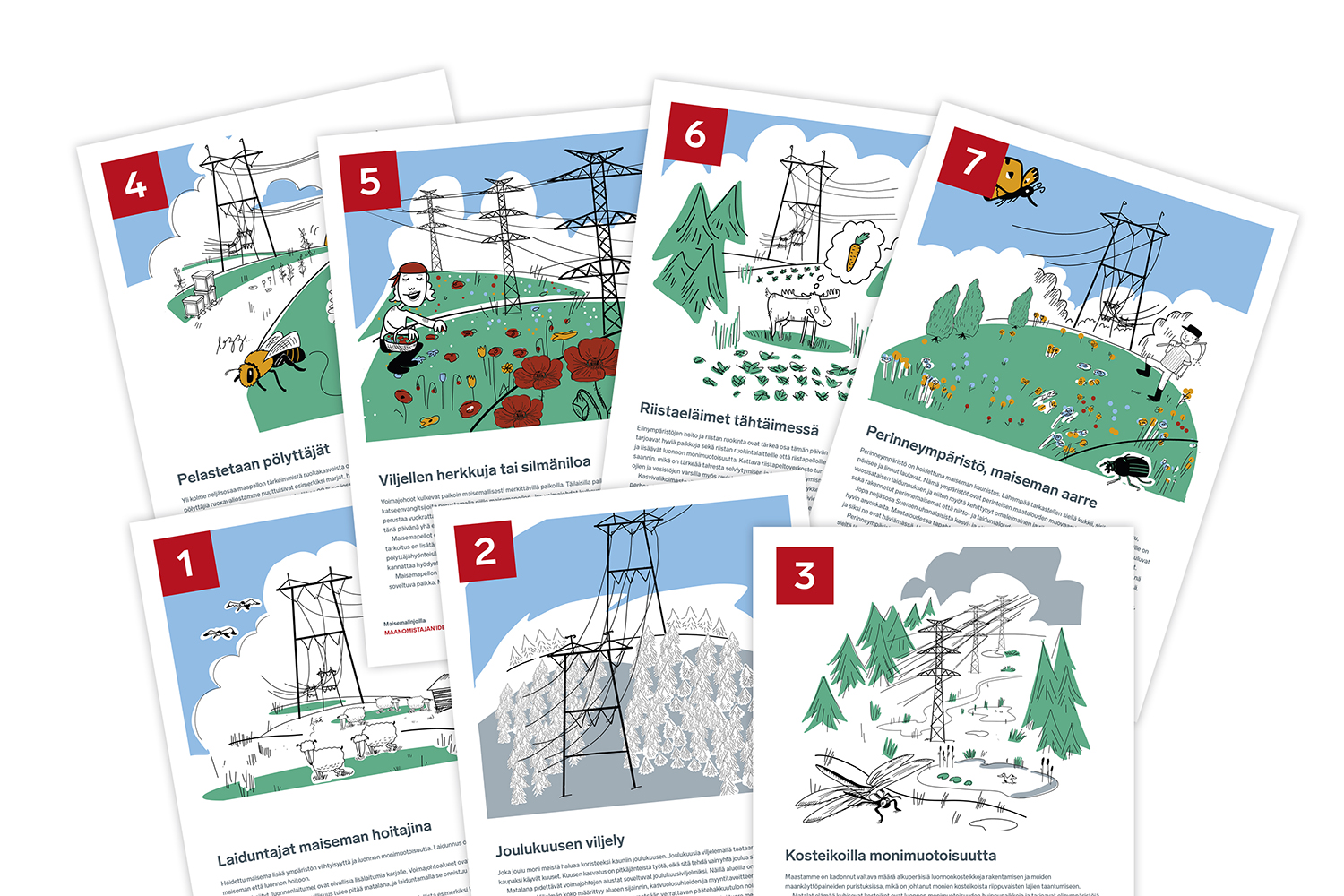Finland, with its long distances, has plenty of transmission line areas. In addition to municipal and city areas, they intersect the land of tens of thousands of landowners. Land under transmission lines belongs to the landowner, while the transmission system operator has a permanent, limited right of use to it.
The landowner has versatile opportunities to utilise the area despite the transmission lines. Different solutions have been implemented all over Finland, and now Fingrid has collected safe and functional ideas in the Landowner’s idea cards. The idea cards summarise information needed for planning and implementing a new purpose of use.
”We have gathered together tips that can be used by as many landowners as possible. The cards’ instructions and information were compiled in cooperation with landscape experts from ProAgria,” Special Advisor Tiina Seppänen from Fingrid tells us.
What would suit me?
Things such as the shape of the terrain and habitat type affect the possibilities of utilising the transmission line area. A sheep pasture or traditional landscapes may suit many transmission line areas.
Furthermore, nearly all cultivated species can be grown in an open transmission line area. When transmission lines are located near populated areas, rented allotment gardens, which are very popular nowadays, can be established in the transmission line area.
Biodiversity can be improved by wetland construction. Original natural wetlands have decreased as a result of construction, which has affected the living conditions of species depending on wetlands.
”We have received some queries about wetland construction. Wetlands support the viability of a great number of species; in addition to insects and amphibians, they also attract waterbirds,” Seppänen explains.
It is possible to apply for investment support or funding for establishing wetlands. An important function of wetlands is to slow down the flow of water through the terrain and thus collect the fine soil carried in the water and the nutrients in it. Some of the wetland area should be shallow open water, and some should consist of vegetation distributed in the area in a mosaic-like fashion. In construction, damming should be favoured over digging.
”In some cases, the utilisation of transmission line areas can produce extra income for the landowner. Constructing wetlands that attract game or increasing biodiversity may be even more significant for some,” emphasises Seppänen.
Safety taken into account
Some basic guidelines restrict the use of a transmission line area. Vegetation up to three metres in height can grow under the lines. Construction and storage of goods is forbidden in the area, but small, portable elements, such as cultivation boxes or the hives of honey bees suit transmission line areas very well. Fingrid’s experts provide instructions and advice for starting up these activities.
Plans for using transmission line areas are reported to Fingrid, which will then provide the landowner with instructions on how the transmission line needs to be taken into account in the plans. It is a good idea to report cultivation, pasturing or other activity, so that the landowner’s activities are not disturbed in connection with transmission line maintenance. Similarly, instructions for moving around enclosures are necessary. Fingrid takes care of regular clearing of transmission line areas around every 5 to 8 years. Border zones are treated at intervals of 10 to 25 years.
It is important to consider safety in area change work. Special care needs to be taken when trees are felled or excavators or cranes are used near the lines. Moving around with work machinery in the actual tower area is not allowed. Advice for area change work and, if needed, help with the felling of trees are available from Fingrid.
Transmission line areas as part of land-use planning
Fingrid’s guidelines for land-use planners from municipalities and cities have been updated. The guidelines also include plenty of information and advice on how to take into account and utilise transmission line areas.
Among other things, the guidelines present basic information on legislation concerning transmission lines, as well as the recommended notation and plan symbols for main grid transmission lines in city and general planning. When the planning of an area close to a transmission line commences, the planner should be in contact with Fingrid as early as in the participation and evaluation phase.
Transmission line areas can be utilised in many ways in municipal land use planning. A ribbon-shaped area can be adapted to become a natural part of a more extensive green network, or a route in a recreational network. For example, a cycle or ski route, nature path, frisbee golf course, parking area or various cultivated areas for local residents are suitable for a transmission line area.
It is a good idea to include transmission line areas in the maintenance classification for green areas. Well-made landscaping or utilisation of the area offers many opportunities for residents and passers-by for recreation and hobbies.
The updated city plan guidelines can be found in PDF format on Fingrid’s website.






